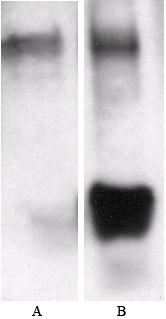
Methylated (ε-N) Lysine Antibody
|
Catalog # Product Description |
ICP0501 The affinity purified rabbit polyclonal anti-methylated lysine antibody was developed using a technique unique to ImmuneChem. The methylated lysine antibodies are affinity purified using N-methyl (epsilon amino group) lysine on agarose as the affinity matrix. The antibodies could be utilized for detection, quantization and isolation of proteins with methylated lysine residues. |
|

Western blot analysis of the methylated histone from melanoma cells with anti-methylated lysine anti-MeK (ICP0501). Histones were isolated with cold 0.1M HCl extraction followed by:
A: Blot with 0.5 μg/mL of anti-MeK (ICP0501) in TBSt and blocked with synthetic methylated BSA 100 μg/mL
B: Blot with 0.5 μg/mL of anti-MeK (ICP0501) in TBSt
|
|
Species
|
Rabbit
|
||
|
Formulation
|
250 μg/mL in Tris-phosphate buffer, 50% glycerol
|
||
|
Immunogen
|
Methylated KLH conjugates
|
||
|
Purification
|
The antibody was immunoaffinity purified with epsilon N-methyl lysine on agarose.
|
||
|
Specificity
|
The antibody recognizes proteins or peptides methylated on lysine residues (mono, di-methyllysine). There are no cross reactions with acetylated proteins. The cross reactivity with tri-methyl lysine has not been tested.
|
||
|
Applications
|
ELISA; WB; IHC
|
||
|
Scientific Description
|
MeK is a conserved post-translational modification and is an important biochemical process for many protein-protein interactions. It is found in many proteins, for example calmodulin, cytochrome C, chromosomal proteins, histones and non-histones as well as neural storage body proteins. It has been suggested that methylation of lysine plays an important role in gene silencing. [1-3]
|
||
|
Storage & Stability
|
Store product at -20°C. Expiration date is one year from date of shipping if stored properly.
|
||
|
Product Specific References
|
2. J. Biol. Chem. 2002. 277: 34655-34657.doi:10.1074/jbc.C200433200 4. Biochem & Biophys Res. Com. 2014. 451 (2): 229-234. doi:10.1016/j.bbrc.2014.07.11 6. Proteomics. 2015. 15 (13): 2166–2176.doi: 10.1002/pmic.201400521 |